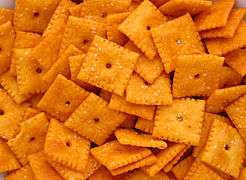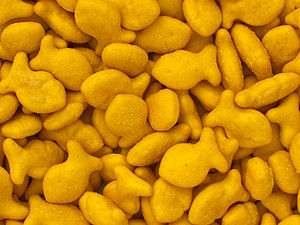Cheese cracker
 A bunch of homemade cheese crackers spiced with rosemary and cinammon | |
| Type | Cracker |
|---|---|
| Course | Main Meal (in some countries, served as a special course) |
| Main ingredients | Cheese |
| Variations | Goldfish, Cheddars, Cheese Nips, Cheez-It |
The cheese cracker is a type of cracker prepared using cheese as a main ingredient.[1][2] Additional common cracker ingredients are typically used, such as grain, flour, shortening, leavening, salt and various seasonings.[3][4][5][6] The ingredients are formed into a dough, and the individual crackers are then prepared.[3][7] Some cheese crackers are prepared using fermented dough.[4] Cheese crackers are typically baked.[1][6] Another method of preparing cheese crackers involves placing cheese atop warm crackers.[8] Cheese crackers have been described as a "high-calorie snack", which is due to a higher fat content compared to other types of crackers.[5]
Uses
In addition to being a snack food, cheese cracker crumbs are sometimes used in recipes as an ingredient, and crumbs or whole crackers are sometimes used as a garnish on various foods.[9][10][11] Cheese crackers are also sometimes served as a side dish to accompany foods.[7]
Commercial brands
Examples of mass-produced commercial cheese cracker brands include Better Cheddars, Cheddars, Cheese Nips, Cheez-It and Goldfish.[1]
- Better Cheddars is a brand of baked Cheddar cheese snack cracker manufactured by Nabisco, a subsidiary of Mondelēz International.[1][12][13]
- Cheddars are a brand of baked Cheddar cheese-flavoured British-style savoury biscuit, having a granular crumbly texture unlike crackers which are harder, more brittle and flaky in texture. They are manufactured by McVitie's.
- Cheese Nips are small cheese-flavored crackers[14] manufactured by Mondelēz International under its brand, Nabisco.
- Cheez-It is a cheese cracker manufactured by the Kellogg Company through its Sunshine Biscuits division. Cheez-Its were introduced in 1921 by the Green and Green company of Dayton, Ohio, and through a series of corporate mergers, the brand was acquired by the Sunshine subdivision of Keebler Company in 1996. Keebler, in turn, was acquired by Kellogg in 2001.
- Goldfish are fish-shaped cheese crackers manufactured by Pepperidge Farm, a division of the Campbell Soup Company.[15]
See also
References
- 1 2 3 4 Davis, Robin (August 23, 2000). "Nabisco Nips the Rest In Cheese Cracker Test". SFGate. Retrieved October 9, 2017.
- ↑ Bohn, R.M. (1957). Biscuit and Cracker Production: A Manual on the Technology and Practice of Biscuit, Cracker, and Cookie Manufacture, Including Formulas. American Trade Publishing Company. p. 104. Retrieved October 9, 2017.
- 1 2 Hui, Y.H.; Corke, H.; De Leyn, I.; Nip, W.K.; Cross, N.A. (2008). Bakery Products: Science and Technology. Wiley. p. 420. ISBN 978-0-470-27632-7. Retrieved October 9, 2017.
- 1 2 Kulp, K. (2000). Handbook of Cereal Science and Technology, Second Edition, Revised and Expanded. Food Science and Technology. Taylor & Francis. p. 670. ISBN 978-0-8247-8294-8. Retrieved October 9, 2017.
- 1 2 Bricklin, M.; Magazine, T.E.P. (1994). Prevention Magazine's Nutrition Advisor: The Ultimate Guide to the Health-Boosting and Health-Harming Factors in Your Diet. Rodale Books. p. 464. ISBN 978-0-87596-225-2. Retrieved October 9, 2017.
- 1 2 Manning, I.; Altman, J. (2013). Crackers & Dips: More than 50 Handmade Snacks. Chronicle Books LLC. pp. 21–22. ISBN 978-1-4521-2417-9. Retrieved October 10, 2017.
- 1 2 Joyce Lamont, L.L.S.Z. (2008). Joyce Lamont's Favorite Minnesota Recipes & Radio Memories. Voyageur Press. p. 25. ISBN 978-1-61060-430-7. Retrieved October 10, 2017.
- ↑ Bulletin. Wisconsin Farmers' institutes. 1896. p. 236. Retrieved October 10, 2017.
- ↑ Butler, A. Audubon Plantation Country Cookbook. Pelican Publishing Company. p. 35. ISBN 978-1-4556-0048-9. Retrieved October 10, 2017.
- ↑ Patch, G. (2013). Christmas Kitchen Cookbook. Seasonal Cookbook Collection. Gooseberry Patch. p. 16. ISBN 978-1-62093-108-0. Retrieved October 10, 2017.
- ↑ The Editors of EatingWell (2016). EatingWell Vegetables: The Essential Reference. Houghton Mifflin Harcourt. p. 159. ISBN 978-0-544-71531-8. Retrieved October 10, 2017.
- ↑ Wood, D.J. (2007). Brands and Their Companies. A Gale trade names directory. Gale Research. p. 210. ISBN 978-0-7876-2287-9. Retrieved October 8, 2017.
- ↑ Milling & Baking News. Sosland Pub. 1988. p. 25. Retrieved October 8, 2017.
- ↑ Myers, Dan (February 28, 2017). "Surprising facts about your favorite snack food brands". Fox News. Retrieved April 14, 2017.
- ↑ Myers, Dan (May 4, 2015). "Things you didn't know about Goldfish crackers". Fox News. Retrieved October 6, 2017.
External links

_with_bags.jpg)

